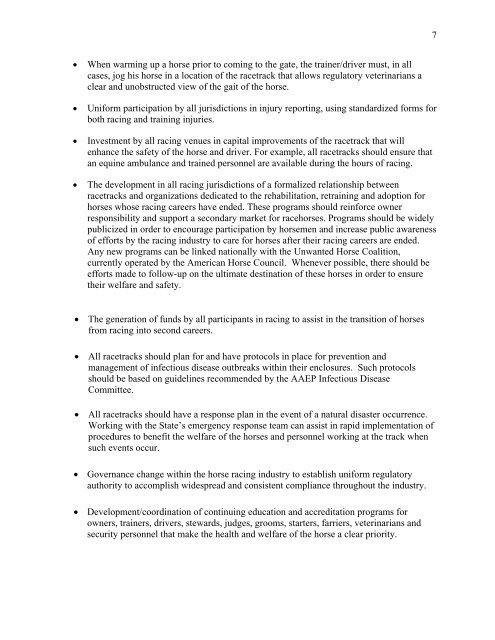Retired Racehorses
tfrr_reportandappendicesfinal
tfrr_reportandappendicesfinal
- No tags were found...
Create successful ePaper yourself
Turn your PDF publications into a flip-book with our unique Google optimized e-Paper software.
7<br />
• When warming up a horse prior to coming to the gate, the trainer/driver must, in all<br />
cases, jog his horse in a location of the racetrack that allows regulatory veterinarians a<br />
clear and unobstructed view of the gait of the horse.<br />
• Uniform participation by all jurisdictions in injury reporting, using standardized forms for<br />
both racing and training injuries.<br />
• Investment by all racing venues in capital improvements of the racetrack that will<br />
enhance the safety of the horse and driver. For example, all racetracks should ensure that<br />
an equine ambulance and trained personnel are available during the hours of racing.<br />
• The development in all racing jurisdictions of a formalized relationship between<br />
racetracks and organizations dedicated to the rehabilitation, retraining and adoption for<br />
horses whose racing careers have ended. These programs should reinforce owner<br />
responsibility and support a secondary market for racehorses. Programs should be widely<br />
publicized in order to encourage participation by horsemen and increase public awareness<br />
of efforts by the racing industry to care for horses after their racing careers are ended.<br />
Any new programs can be linked nationally with the Unwanted Horse Coalition,<br />
currently operated by the American Horse Council. Whenever possible, there should be<br />
efforts made to follow-up on the ultimate destination of these horses in order to ensure<br />
their welfare and safety.<br />
• The generation of funds by all participants in racing to assist in the transition of horses<br />
from racing into second careers.<br />
• All racetracks should plan for and have protocols in place for prevention and<br />
management of infectious disease outbreaks within their enclosures. Such protocols<br />
should be based on guidelines recommended by the AAEP Infectious Disease<br />
Committee.<br />
• All racetracks should have a response plan in the event of a natural disaster occurrence.<br />
Working with the State’s emergency response team can assist in rapid implementation of<br />
procedures to benefit the welfare of the horses and personnel working at the track when<br />
such events occur.<br />
• Governance change within the horse racing industry to establish uniform regulatory<br />
authority to accomplish widespread and consistent compliance throughout the industry.<br />
• Development/coordination of continuing education and accreditation programs for<br />
owners, trainers, drivers, stewards, judges, grooms, starters, farriers, veterinarians and<br />
security personnel that make the health and welfare of the horse a clear priority.


